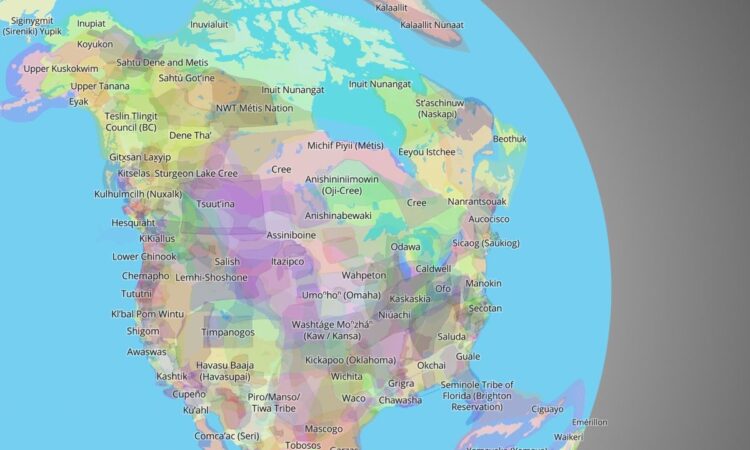
:focal(778x496:779x497)/https://tf-cmsv2-smithsonianmag-media.s3.amazonaws.com/filer_public/f9/15/f915c2aa-bc53-48af-8ab6-33fb2cf4a612/screen_shot_2023-11-01_at_115810_am.jpeg)
A screenshot of Native Land Digital’s interactive map
Native Land Digital
In 1990, the month of November was officially designated Native American Heritage Month in the United States. “Native American Indians were the original inhabitants of the lands that now constitute the United States of America,” the government resolution read, noting Native peoples’ “essential and unique contribution to our nation.” This November, you can learn more about North America’s first inhabitants by finding out which Indigenous lands you live on, using a collaborative, interactive map.
Since launching on Native-Land.ca in 2015, the tool has helped people discover the history of the land they inhabit. Created by Victor Temprano and now overseen by Indigenous-led nonprofit Native Land Digital, the map first functioned as a “resource pointed at settlers and non-Indigenous people to, in a not-too-confrontational way, start thinking about Indigenous history,” Temprano told Mashable’s Heather Dockray in 2018.
Today, Native Land Digital is focused on improving both Indigenous and non-Indigenous people’s relationships with the lands around them through education. Per a Facebook post, they “hope to strengthen the spiritual bonds that people have with the land, its people and its meaning.” They strive to “create and foster conversations about the history of colonialism, Indigenous ways of knowing and settler-Indigenous relations.”
The map is built from user contributions and feedback, with developers consistently updating and editing it using new information. In May 2023, Native Land Digital collaborated with the Partnership for the National Trails System to launch Native Lands, National Trails, a map identifying the Indigenous lands hikers trek through on trails. Kiana Etsate-Gashytewa led the project, and, as she tells Conde Nast Traveler, Native Land Digital’s data is unique, inclusive and encompassing.
“It’s being crowdsourced, which is more relevant and applicable, as it’s so Indigenous in the way we hold and care for our knowledge,” says Etsate-Gashytewa. “Our elders, who have years of knowledge, understanding and experience, don’t need PhDs to have their voices validated when suggesting an edit on the site.”
As Temprano writes, the map’s popularity usually spikes around Canada’s National Aboriginal Day (June 21), Columbus Day—now designated Indigenous People’s Day in the U.S.—and Thanksgiving. On the website, users can type their city, state or ZIP code into a search bar to see which Indigenous communities reside or resided there. The tool includes an option to apply “settler labels” to see how the map corresponds with today’s state borders. If users click on the names of Indigenous nations, they’ll find links to related readings.
“[The project] is supporting Indigenous peoples as they take back the narrative and have both the ability and the platform to be able to share their stories,” Christine McRae, former executive director of Native Land Digital, told Today’s Danielle Campoamor. “In doing so, we’re able to know a truer history of the place that we live in.”
In addition to the map, the website includes a teacher’s guide to creating a lesson about Indigenous land, as well as geotagged lists of Indigenous languages and treaties. Users can click on a language to see where it’s spoken, or on a treaty to examine the area involved in a particular “Indian Land Cession.” Cessions, or treaties, occurred when colonial settlers like the United States or Britain successfully offered money or goods to Native peoples in exchange for their territory. The practice, peacefully exploitative in the early colonization of North America, turned violent by the turn of the 19th century, when colonists began more violent campaigns to force Indigenous people from their ancestral land.
To encourage recognition of that long history of displacement, Native Land Digital also provides a guide to territory acknowledgements.
“Territory acknowledgement is a way that people insert an awareness of Indigenous presence and land rights in everyday life,” writes the nonprofit. “This is often done at the beginning of ceremonies, lectures or any public event. It can be a subtle way to recognize the history of colonialism and a need for change in settler colonial societies.”
Still, territory acknowledgements are complex; sometimes they “can easily be a token gesture rather than a meaningful practice,” they continue. The website presents a number of questions for reflection and suggests reaching out to nearby Indigenous communities directly.
Next time you hear a land acknowledgement, please remember that acknowledging the land where one is standing does not make up for the history that it was taken from Indigenous people.
— Lisa Richardson MD (@RicharLisa) May 19, 2021
Diana Cournoyer, executive director at the National Indian Education Association and a member of the Oglala Sioux Tribe, told Today that conversations about Indigenous history can be uncomfortable—but at the same time, they should aim to center Indigenous joy.
“Native people exist in pride today,” Cournoyer said. “We are thriving, we are innovating, we are creative, we are problem solvers, we are economic drivers in a lot of states, we make decisions and we are highly educated.”
Native Land Digital hopes that the map will provide young people with an interactive way to learn about Indigenous communities and start conversations surrounding Indigenous rights, McRae told Today.
“We have a responsibility to learn the history so that we don’t continue to perpetuate harm,” she said. “We’re having more and more of those conversations, and I’m very hopeful listening to a lot of youth from around the world who are incredible advocates and who make sure we take care of the land that we’re on, and who make sure that this land remains for future generations.”
